Blog

Obesity exerts a profound influence on the health of our feet, a fact often underestimated in the broader conversation about weight-related health issues. The excess body weight borne by those individuals who are obese places an extraordinary burden on the feet, subjecting them to increased pressure and stress. This heightened load on the feet can lead to a range of debilitating conditions, ranging from arch collapse and plantar fasciitis to osteoarthritis. The intricate network of bones, muscles, and ligaments in the feet can gradually succumb to the relentless strain, possibly resulting in chronic pain and reduced mobility. Moreover, obesity amplifies the risk of developing conditions like diabetes, further compounding the toll on foot health. If you have developed foot pain as a result of being overweight, it is suggested that you confer with a chiropodist who can help you to manage this condition.
Being obese affects every part of your body, and your feet are no exception. Because they bear the full weight of your body as you go about your daily life, your feet are under a lot of pressure. Carrying excess weight can strain the feet and cause a variety of unpleasant side effects. If you are obese and concerned about your foot health, please consult with one of the specialists from Thornhill Foot Clinic. Our chiropodists can help you maintain the health of your lower limbs and your mobility.
Obesity can:
Cause foot pain
Increase the risk of foot and ankle injuries
Reduce mobility
Make the feet wider
Flatten the arch
Make gout more likely
Make arthritis more likely
Increase the risk of diabetes
Your chiropodist may suggest lifestyle changes to address foot and ankle problems that are caused by or affected by obesity. These may include changes to your diet, exercise, and footwear, as well as wearing orthotics. The treatments for specific injuries or health problems will vary depending on what they are, but weight loss is often suggested to decrease strain on the feet. If you have any questions, please feel free to contact our office located in . We offer the newest diagnostic and treatment technologies for all your foot care needs.
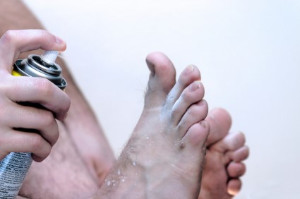
Athlete's foot is a common fungal infection that can cause itching, burning, and discomfort. Prevention is key to keeping this irritating condition at bay. Firstly, keeping your feet clean and dry is essential. Wash them daily with soap and water, ensuring they are dried thoroughly, especially between the toes. Fungi thrive in damp environments, so maintaining dry feet is your first line of defense. Choosing the right footwear is equally important. Opt for shoes made of breathable materials and moisture-wicking socks to help keep your feet fresh and dry. It is beneficial to refrain from walking barefoot in public places, especially in locker rooms, swimming pools, and communal showers. Wearing flip-flops or shower shoes can protect your feet from infection. It is helpful to avoid sharing socks or towels. Fungal infections can spread through contact, so avoid borrowing or lending these items. If you have developed athlete’s foot, it is strongly suggested that you contact a chiropodist who can offer you successful treatment options, in addition to effective prevention techniques.
Athlete’s foot can be uncomfortable and unsightly. To learn more about preventing and treating this condition, please consult with one of the specialists from Thornhill Foot Clinic. Our chiropodists will assess your condition and provide you with quality foot and ankle treatment.
What Is Athlete’s Foot?
Athlete’s foot refers to an infection of the skin on the feet that is caused by a fungus. This fungus is contagious and thrives in warm and moist environments. It is often spread in common areas such as public pools, locker rooms, and showers. It can also spread when sharing personal items, like shoes or towels, with an infected person.
Symptoms
The symptoms of athlete’s foot may include:
Itching, stinging, or burning of the skin on the feet
Cracking or peeling skin, especially between the toes and on the soles of the feet
Scaly, red rash on the foot
Blisters
Foul odor
Treatment
Treatment for athlete’s foot typically involves using over-the-counter topical antifungal medications on the feet. When over-the-counter options are ineffective, you may need to take prescription oral medications or topical antifungal drugs, or a combination of both.
Prevention
Preventing athlete’s foot places an emphasis on good foot hygiene practices.
You can prevent athlete’s foot by:
Washing and drying your feet thoroughly every day
Wearing shoes when walking in public areas
Not sharing personal items, like shoes or socks, with others
Wearing shoes and socks made out of breathable materials
If you have any questions, please feel free to contact our office located in . We offer the newest diagnostic and treatment technologies for all your foot care needs.
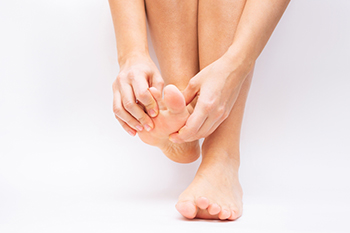
Toe pain in diabetic patients unfolds as a manifestation of the intricate relationship between diabetes and foot health. Elevated blood sugar levels, a hallmark of diabetes, contribute to nerve damage, a condition known as diabetic neuropathy. This peripheral neuropathy often affects the extremities, including the toes, leading to sensations of tingling, burning, or pain. Reduced blood circulation, another consequence of diabetes, compounds the vulnerability of the toes to injury and infection. Consequently, even minor issues like ingrown toenails or blisters can escalate, causing discomfort and potential complications. Toe pain in diabetic patients serves as a vital warning sign, signaling the need for vigilant foot care. Regular foot examinations, proper hygiene, and prompt intervention for any abnormalities become paramount to prevent severe consequences such as foot ulcers. They also ensure that diabetic individuals prioritize comprehensive foot health in their overall diabetes management strategy. If you have diabetes, it is strongly suggested that you are under the care of a chiropodist who can help you to manage this condition.
Toe pain is common and can have a variety of causes. Causes can range from a broken toe to an ingrown toenail. Many types of toe pain can be corrected, but any toe pain that inhibits your activities for an extended period should be discussed with a chiropodist. If you suffer from toe pain, please consult with one of the specialists from Thornhill Foot Clinic. Our chiropodists can help you maintain the health of your feet.
Common Causes of Toe Pain
- Trauma or fracture
- Cuts, sores, or bruises
- Rheumatoid arthritis
- Gout
- Turf Toe
- Morton’s neuroma
- Blisters
- Corns
- Bunions
- Hammertoes
- Ingrown toenails
- Plantar warts
- Athlete’s Foot
Symptoms of Toe Pain
- Toe deformity
- Burning
- Numbness
- Toenail deformity
- Wart or ulcer
- Swelling
- Redness
When to See a Chiropodist
- Bleeding or severe swelling
- Trauma, such as a broken bone
- Discoloration or extreme swelling
- Inability to bear weight
- Persistent pain
- Wounds that won’t heal
Diagnosis of Toe Pain
A chiropodist can conduct a thorough examination of the painful toe or toes in order to determine the best course of treatment. The exam may include assessing the tenderness of the area, taking an X-ray or other diagnostic test, or assessing your gait and range of motion. A discussion of what led to the advanced pain issue may follow. Included will likely be a health history, as well as a list of medications you are taking and other previous injuries you may have sustained.
Treatment for Toe Pain
With such a wide range of possible causes for toe pain, treatment can be varied in scope and length. Sometimes, the chiropodist will recommend lifestyle and activity changes. In cases of trauma or other injuries, X-rays or imaging tests will likely be used to determine the severity of the problem, particularly if any bones have been broken. Treatment may also include injections of pain-relief medication or anti-inflammatory drugs. Certain injuries will require the splinting, bracing, or wrapping of injured toes. Orthotics or special shoes may be prescribed in cases of bone deformities and gait issues. Removal of warts, calluses, and corns may be needed. In other cases, such as with patients who have diabetes or rheumatoid arthritis, ongoing treatment may be required to avoid more serious problems.
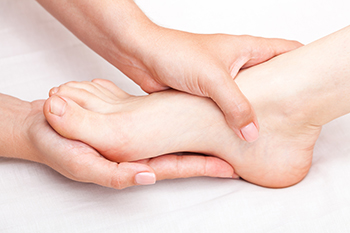
Chiropodists offer invaluable assistance to the elderly population by addressing a range of foot-related concerns and improving their overall well-being. These healthcare professionals play a vital role in promoting mobility, comfort, and quality of life for older individuals. Chiropodists provide essential foot care services, ensuring that the elderly population maintain healthy feet. They assess and treat various issues such as toenail trimming, callus and corn management, and fungal infections. For seniors with chronic conditions like diabetes or arthritis, chiropodists can help prevent complications by monitoring and managing foot health. They evaluate circulation and sensation, reducing the risk of ulcers and infections. Orthotics and custom footwear are often recommended by chiropodists to enhance balance and stability, reducing the risk of falls among the elderly. Additionally, chiropodists offer valuable advice on foot care routines and footwear selection tailored to the specific needs of older individuals, ensuring they can maintain an active and comfortable lifestyle. If you are a senior or providing care for one, it is suggested that you schedule routine appointments with a chiropodist.
If you have any foot or ankle concerns, contact one of the specialists of Thornhill Foot Clinic. Our chiropodists can provide the care you need to keep you on your feet.
A chiropodist is a healthcare professional that specializes in the feet, ankles, and lower limbs. With the amount of work the feet do in a lifetime, the whole body works better if the feet are properly supported. Chiropodists must have a bachelor’s degree in science and complete a three to four-year chiropody program. They can then work independently or as part of a team. Chiropodists are like podiatrists, the only difference being the country they obtained where they obtained their degrees. The field can be called podiatry in the United States and chiropody elsewhere. A chiropodist is a popular term for this profession in the UK and Canada. Chiropodists treat a variety of foot problems from corns and calluses to fungal infections. Some also offer orthotics. They might provide a variety of foot therapies, injections, and surgical procedures. Normally one sees a chiropodist when they are experiencing pain but visiting one regularly, as one would a dentist, can help ensure the feet are in top form and help prevent future problems. If you suffer from foot or ankle pain or have questions about your lower extremities, book an appointment with a chiropodist today.
What Does a Chiropodist Do?
A chiropodist helps people with problems with their feet and ankles with the goal of making their lives more comfortable. A chiropodist takes care of blisters, corns, bunions, cracked heels, nail problems, and sprained ankles, just to mention a few things that can go wrong with our feet. A chiropodist will take your medical history and examine your feet for blood circulation and any other problems going on. They will watch you walk and how you move when you walk. They will discuss any findings they come up with and discuss a treatment plan with you.
What Does It Take to Become a Chiropodist?
Chiropodists must have seven to eight years of post-secondary school before beginning to practice. They must obtain a bachelor’s degree in science and complete a three-to-four-year chiropody program. Chiropodists work independently or as part of a team.
If you have any questions please feel free to contact our office located in Vaughan, ON . We offer the newest diagnostic tools and technology to treat your foot and ankle needs.

Ensuring warm and comfortable feet during the winter months involves mindful practices that prioritize both health and comfort. Begin by selecting insulated footwear, ideally with a waterproof exterior to shield against snow and moisture. Layering socks provides an effective barrier against the cold, with moisture-wicking materials keeping feet dry. Choose thermal or wool socks for enhanced insulation. Wearing properly fitted footwear is essential, as tight shoes can impede circulation, leading to cold feet. When venturing outdoors, ensure your footwear is equipped with slip-resistant soles to prevent slips on icy surfaces. Utilize foot warmers or heated insoles for an extra layer of warmth during prolonged exposure to cold temperatures. Regular foot massages or warm foot baths can help to stimulate blood circulation, promoting warmth from within. If you are interested in learning more about effective foot warmth during the cold months, it is suggested that you schedule an appointment with a chiropodist.
The winter months can bring about new or worsening foot and ankle problems. If you’re suffering from foot or ankle pain, please consult with one of the specialists from Thornhill Foot Clinic. Our chiropodists can help you maintain the health of your lower limbs and your mobility.
Winter Foot Problems
Cracked heels - Dry, cracked skin on the heels of the feet that is associated with cold, dry weather
Athlete’s foot - A fungal infection on the skin of the feet
Blisters - Fluid-filled bubbles of skin that usually form in response to friction
Fractures - Broken bones in the feet or ankles
Metatarsalgia - General foot pain
Chilblains - Spasming of the small blood vessels in the toes in response to exposure to cold weather
Raynaud’s disease - Numbness, pain, and color changes in the toes due to cold weather
Prevention
Wear warm socks and shoes
Avoid prolonged exposure to the cold
Moisturize the heels regularly
Keep your feet clean and dry
Walk carefully in areas that may be icy
Wear non-slip shoes
If you have any questions, please feel free to contact our office located in . We offer the newest diagnostic and treatment technologies for all your foot care needs.

Ankle pain, a common ailment that can disrupt daily activities, stems from a variety of underlying factors. One prevalent cause is injury, often resulting from sprains, strains, or fractures. Ligaments that connect bones in the ankle may stretch or tear, triggering pain and swelling. Overuse or repetitive strain, particularly in activities like running or high-impact sports, can lead to inflammation and discomfort. Conditions such as arthritis, affecting the joints, may contribute to persistent ankle pain. Tendinitis, an inflammation of the tendons surrounding the ankle joint, is another culprit, often aggravated by overexertion. Additionally, underlying health issues such as nerve compression or circulatory problems can manifest as ankle pain. Footwear choices, improper gait, and muscle imbalances can also play a role. Recognizing the diverse causes of ankle pain is essential for an accurate diagnosis and effective treatment. If you have ankle pain, it is strongly suggested that you are under the care of a chiropodist who can accurately determine what the cause is, and offer correct treatment options.
Ankle pain is a common symptom of many lower limb problems. If you are experiencing ankle pain, please consult with one of the specialists from Thornhill Foot Clinic. Our chiropodists will assess your condition and provide you with quality foot and ankle treatment.
The ankle is composed of a number of muscles, bones, tendons, and ligaments. There are many conditions which may cause ankle pain.
Causes
Ankle strains or sprains
Achilles tendon injuries
Fractures
Bursitis
Arthritis
Gout
Tarsal tunnel syndrome
Symptoms
If you have ankle pain, you may also experience a variety of other symptoms depending on the underlying cause of the pain. Some of these symptoms may include ankle swelling, bruising, redness, numbness or tingling, instability, and difficulty walking.
Diagnosis
The underlying cause of ankle pain can be diagnosed by a chiropodist. Diagnoses are typically made based on your medical history, a physical examination of the affected ankle, and imaging studies such as X-rays.
Treatment
Treatment for your ankle pain will depend on its underlying cause. Often, the chiropodist will recommend that you rest the affected ankle. You might also need to ice, compress, and elevate the ankle, wear an orthotic device, or take medications to reduce pain and inflammation.
If you have any questions, please feel free to contact our office located in . We offer the newest diagnostic and treatment technologies for all your foot care needs.
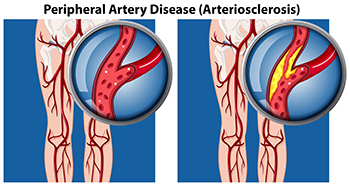
Cholesterol can become a silent menace when levels soar. Beyond the commonly known risks to heart health, high levels of cholesterol can have a profound effect on your feet. A key consequence of elevated cholesterol is atherosclerosis, a condition where plaque accumulates in the arteries. This buildup can affect the extremities, including the legs and feet, resulting in peripheral artery disease, or PAD. A common symptom of the reduced blood flow to the lower extremities is unusually cool or cold feet. Swelling or edema may also occur, particularly after periods of immobility. Leg pain, another common indicator of PAD, may be experienced with or without physical activity. A sensation described as having pins and needles often occurs in the feet. PAD may also increase the risk of developing arterial ulcers, which are slow-healing wounds that typically appear on the legs, feet, ankles, or toes. These ulcers are a consequence of damaged cells, tissues, and nerves. For those individuals with PAD and leg ulcers, careful observation is needed. If you are experiencing the symptoms of peripheral artery disease, it is suggested that you make an appointment with a chiropodist who can determine what the best treatment is for you.
Peripheral artery disease (PAD) is a condition that causes poor circulation in the lower limbs. If you have PAD, please consult with one of the specialists from Thornhill Foot Clinic. Our chiropodists can help you maintain the health of your lower limbs and your mobility.
What is peripheral artery disease?
Peripheral artery disease is characterized by reduced blood flow to the lower limbs. This occurs due to a buildup of a fatty substance called plaque in the arteries. The plaque causes the arteries to become narrow and harden, which makes it difficult for blood to get to the lower limbs. Without adequate blood flow, the tissues of the legs, ankles, and feet do not get enough oxygen and nutrients to function properly, which can lead to various symptoms as the condition progresses. Having poor circulation also increases your risk of cardiovascular events, such as heart attacks and strokes.
Symptoms
In its initial stages, PAD is often asymptomatic. If symptoms do arise, they often include:
Muscle cramps
Weakness
Fatigue
Pain that gets worse with physical activity
Balance problems
Difficulty walking
Diagnosis
PAD can be diagnosed through a thorough physical examination, medical history, and vascular testing. There are many simple, non-invasive tests that your chiropodist can use to determine your risk of having PAD. These include the ankle-brachial index (ABI) test and Doppler ultrasounds.
Treatment
Treatments for PAD focus on lifestyle changes and medication management to lessen symptoms and prevent heart attacks and strokes. Your chiropodist may suggest various foot and ankle exercises to increase the strength and flexibility of your feet and ankles, boost circulation, and improve mobility. They may also suggest routine visits to monitor and maintain the health of your feet since poor circulation can lead to a variety of foot and ankle complications.
If you have any questions, please feel free to contact our office located in . We offer the newest diagnostic and treatment technologies for all your foot care needs.
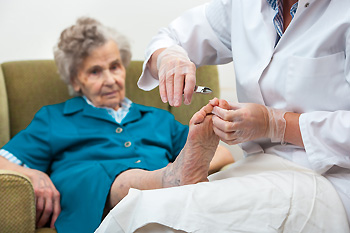
Caring for your feet is important to your overall health, but is often underestimated in self-care routines. Establishing a routine for good foot hygiene is essential for keeping your feet healthy and happy as you get older. Daily washing, with extra attention to the spaces between your toes, significantly lowers the risk of infections. As the skin on your feet tends to become thinner and drier with age, follow up with moisturizing lotion, excluding the areas between the toes to avoid creating a damp environment conducive to fungal growth. Proper toenail maintenance is needed to prevent ingrown toenails. If you cannot trim them yourself, a care worker or a chiropodist can perform that task safely. Addressing calluses is equally important. Deep calluses can crack and bleed, posing a risk of infection. Regular self-examination of your feet is essential. Check the tops, soles, and under the toenails, in addition to the spaces between your toes for any changes, growths, or discolorations. Swelling or changes in color may indicate poor circulation or other problems that require prompt attention. For individuals with diabetes or rheumatoid arthritis, communicate with your chiropodist about any unusual or concerning developments. For guidance in the proper care for your feet, it is suggested that you schedule an appointment with a chiropodist.
Foot problems can become increasingly common as we age, making everyday foot care especially important. To learn more about maintaining proper foot health, please consult with one of the specialists from Thornhill Foot Clinic. Our chiropodists will assess your condition and provide you with quality foot and ankle treatment.
Common Foot Problems
Certain foot problems may be more likely to affect older adults.
Some examples of foot conditions that can be common in older adults include:
Dry, cracked skin
Calluses and corns
Blisters
Ingrown toenails
Deformities such as bunions or hammertoes
Fungal infections
Plantar warts
Systemic conditions, such as diabetes or arthritis, are also more likely to affect older people and manifest symptoms in the feet and ankles.
Daily Foot Care Tips
Having a daily foot care routine can help detect problems early on and prevent future issues.
Things that you can do at home to care for your feet include:
Washing the feet daily with warm water, drying them thoroughly, and then applying a moisturizer
Trimming the toenails straight across and not too short to prevent ingrown toenails
Performing daily foot exercises to improve foot strength and mobility
Wearing shoes when walking to avoid injury
Inspecting the feet daily for any cuts, scrapes, sores, or other abnormalities and seeking prompt treatment if any problems are discovered
If you have any questions, please feel free to contact our office located in . We offer the newest diagnostic and treatment technologies for all your foot care needs.
Blog Archives
- 2025
- 2024
- 2023
- 2022
- 2021


